Abstract
The Internet of Things (IoT) is a revolutionary advancement that automates daily tasks by interacting between digital and physical realms through a network of mostly Low-Power IoT (LP-IoT) devices. For an IoT ecosystem, reliable wireless connectivity is essential to ensure the optimal operation of LP-IoT devices, especially considering their limited resource capacity. This reliability is often achieved through channel estimation, an essential aspect for optimising signal transmission. Considering the importance of reliable channel estimation for constrained IoT devices, we developed two lightweight yet effective channel estimation models based on Random Forest Regressor (RFR). These two models are namely classified as Feature-based RFR(F) and Sequence-based RFR(S) methods and utilise Received Signal Strength Indicator (RSSI) as a fundamental channel metric to enhance efficiency for the reliability of channel estimation in constrained LP-IoT devices. The models’ performance was assessed by comparing them with the state-of-the-art and our previously developed Artificial Neural Network (ANN)-based method. The experimental results show that the RFR(F) method shows approximately 39.62% improvement in Mean Squared Error (MSE) over the Feature-based ANN(F) model and 37.86% advancement over the state-of-the-art. Similarly, the RFR(S) model shows an improvement in MSE of 24.9% compared to the Sequence-based ANN(S) model and an 80.59% improvement compared to the leading existing methods. We also evaluated the lightweight characteristics of our RFR(F) and RFR(S) methods by deploying them on Raspberry Pi 4 Model B to demonstrate their practicality for LP-IoT devices.
1. Introduction
The Internet of Things (IoT) technology has revolutionised regular living activities into automated operations by facilitating the interconnectedness between the physical and digital world [1]. In such interconnected environments, reliable communication is crucial, particularly for constrained Low-Power IoT (LP-IoT) devices. Channel estimation is performed to ensure reliable wireless communication by optimising signal strength and enhancing the efficiency of such devices in an interconnected ecosystem. The primary metric for wireless channel estimation in LP-IoT networks is the Received Signal Strength Indicator (RSSI). To recognise the pattern of the RSSI, researchers have conducted numerous studies using RSSI and enhanced the accuracy of signal transmission for such LP-IoT networks [2,3,4].
Recent research has increasingly recognised Machine Learning (ML) as a potential method for enhancing channel estimation accuracy [5]. The studies in [6,7] have demonstrated the capability of ML in predicting channel characteristics. A further study in [8] illustrated the effectiveness of Supervised ML (SML) in RSSI-based indoor localisation for IoT applications, underscoring the benefits of ML over traditional estimation methods. Deep Learning (DL), as an advanced ML paradigm, has also emerged as a noteworthy research area of exploration in wireless channel estimation [9]. The DL-based methods utilise Artificial Neural Networks (ANNs) for their model development [10]. A notable contribution, presenting the theoretical significance of DL for single-input multiple-output (SIMO) systems, can be seen in [11]. This method reduced the Minimum Mean-Squared Error (MMSE) in different settings, even without pre-existing channel data. This study also highlights DL’s potential to outperform traditional methods. In the realm of indoor positioning, the study in [12] developed an accurate localisation model utilising Recurrent Neural Networks (RNNs), particularly Long Short-Term Memory (LSTM) and Gated Recurrent Unit (GRU) variations for WiFi fingerprinting. This study affirmed the enhanced localisation accuracy of RNN models over traditional methods. While DL-based solutions have provided promising results in IoT channel estimation [13], they also pose challenges related to high computational demands. Thus, these approaches require further improvement to balance accuracy enhancement with computational efficiency in channel estimation tasks.
Building upon the promising implementation of ML-based channel estimation, researchers are increasingly exploring simpler ML algorithms to streamline the complexity associated with ANN-based models. A standout in this field is the Random Forest (RF) algorithm [14]. RF is an ML approach that enhances prediction accuracy and robustness by integrating numerous decision trees. It is capable of handling complex datasets without requiring extensive preprocessing [15]. Its efficiency and lightweight nature make RF particularly suitable for deployment in the resource-limited settings of IoT devices. A study by [16] effectively demonstrates the implementation of the Random Forest algorithm for predicting RSSI values. However, it lacks details on the number of trees used, the data collection process, and the deployment strategy. These gaps highlight the need for a more comprehensive study of RF-based RSSI prediction.
By leveraging the motivations and challenges related to RF-based channel estimation for IoT networks [17,18], this paper implements a variant of the RF algorithm called Random Forest Regressor (RFR) to estimate RSSI as a channel metric in indoor LP-IoT networks. The following are the main contributions of this research:
- Implemented an RFR-based channel estimation method utilising Feature-based and Sequence-based strategies, demonstrating enhanced accuracy and efficiency for LP-IoT channel estimation.
- Conducted a comparative analysis against existing research and ANN-based methods, highlighting the substantial improvement in estimation error and training and testing time.
- Validated the lightweightness of developed RFR models over ANN-based models by deploying them on the Raspberry Pi 4 Model B platform.
The rest of the paper is organised as follows: Section 2 reviews recent developments in the field of LP-IoT channel estimation and outlines the current challenges pertinent to this research. Section 3 presents the system model that highlights the research process flow, and the problem formation used in this research. Section 4 presents the structure of the two RFR-based models used for this study. The experimental setup used to evaluate the practical performance of the models on LP-IoT devices is explained in Section 5. Section 6 presents the discussion around the results. Section 7 concludes the paper, and provides future research directions.
The subsequent section provides a brief review of existing studies on ML-based channel estimation techniques for RSSI prediction in IoT networks. This review identifies the strengths, limitations, and gaps in current research that serve as the basis for the development of our proposed approach.
2. Related Work
Wireless channel estimation in Low-Power Internet of Things (LP-IoT) networks constitutes a significant research domain. Its application is essential for energy efficiency, precise localisation, and reliable link quality evaluation [19]. The implementation of ML methodologies, such as Random Forest (RF), Support Vector Machine (SVM), and Deep Learning (DL)-based models, has garnered considerable interest and provided improved accuracy and flexibility in the field of channel estimation [20]. Recent studies based on RSSI-based channel estimation using ML models have demonstrated enhanced accuracy for indoor localisation, as demonstrated in [14,21].
Similarly, predictive ML-based models such as Decision Trees (DT) and SVM have shown prominent enhancement for IoT networks by estimating RSSI for changing weather and environmental factors, as mentioned in [22,23]. However, these developed models can be computationally intensive and may require recalibration, which creates a challenge when utilised in real-time applications for LP-IoT networks. RSSI estimation in outdoor settings, such as forested or agricultural areas, has also benefitted from ensemble learning and regression models incorporating environmental data [5,24]. These methods account for natural obstructions but struggle with fluctuating environmental factors and demand higher computational resources. Recent studies on power optimisation integrate RSSI estimation with environmental factors to balance energy efficiency with signal accuracy [7,25]. However, these models also often require complex calculations and periodic updates, which may be infeasible for LP-IoT devices. Moreover, ML has enhanced Signal-to-Interference-plus-Noise Ratio (SINR) and SNR predictions in 5G/6G and Wi-Fi networks [26,27]. Although these approaches provide accurate estimations, they are also resource-heavy and challenging, even when adapted to simpler LP-IoT networks, specifically indoor networks. Time series ML models like LSTM and CNN have also shown promising outcomes in real-time RSSI prediction, especially for dynamic environments [28,29]. However, these techniques also face a similar challenge of meeting computational demand, which exceeds typical LP-IoT capacities.
Overall, the significant limitations of wireless channels in indoor LP-IoT networks, from signal fluctuations to constrained computational resources, limit the scalability of the developed models across varied settings. ML techniques, particularly RF and ensemble methods, have improved RSSI estimation for diverse LP-IoT applications to resolve these issues. However, challenges remain in balancing the model’s complexity with IoT constraints, such as limited power and computational capacity. Therefore, there is a need to develop lightweight ML models that combine the adaptability of ML with the simplicity required for efficient deployment in constrained environments.
3. System Model
This section describes the system model used for this study that set the context of the research problem and the followed process. We consider a conceptual communication model for the LP-IoT system in which a signal is transmitted through a wireless channel and received by the receiver IoT device, which can be represented as follows:
where x denotes the transmitted signal, h represents the wireless channel between the transmitter and receiver, and n represents the noise added to the system. To visualise the problem more practically, let us consider a downlink IoT system as shown in Figure 1, where the channel h is represented as a complex number and is denoted as . In this downlink LP-IoT system, we intend to compute the LP-IoT wireless channel gain h in for LP-IoT networks. For ease of estimation, we take the norm of vector h that becomes the scalar. Thus, the channel gain is expressed as , where indicates the RSSI measured in real-time from the laboratory settings.
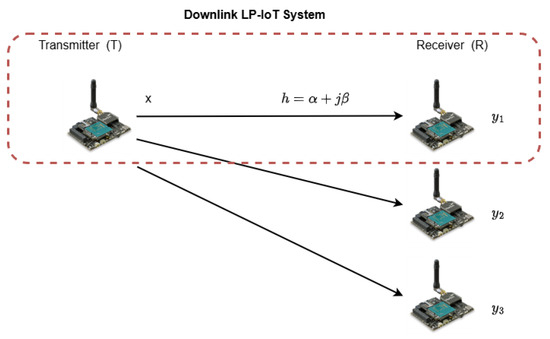
Figure 1.
A conceptual communication model for LP-IoT system.
The system model presented in this paper is based on the data collected from three distinct scenarios established via hardware setup in the Network Engineering Laboratory at Charles Sturt University (CSU). This setup simulates real-world IoT communications using two Waspmote devices for transmitting and receiving signals. The measured RSSI is the primary channel metric across three scenarios representing typical IoT wireless channels under Line of Sight (LoS) and Non-Line of Sight (NLoS) conditions. The first scenario tested stationary devices at a fixed distance of 3 m, both with and without physical barriers, to establish a baseline for signal strength. The second scenario examined the impact of varying the receiver’s position within a fixed 3-meter distance by adding common laboratory objects to simulate NLoS conditions. The third scenario explored varying distances between the transmitter and receiver, from 0.2 to 2.9 m, under both LoS and NLoS conditions. The first experiment ran for over three hours in the initial setup, collecting 10,000 samples per condition, while scenarios 2 and 3 were tested for approximately five minutes each, yielding 220 to 260 samples per location due to random packet loss. In total, 43,163 RSSI samples were obtained, and the dataset was thoroughly cleansed to eliminate any empty entries before the model implementation.
Next, we consolidated the data collected from the different experimental scenarios into a single spreadsheet. The specific input features in the prepared data spreadsheet are distance, condition, and category. The output against those features is the RSSI. Table 1 shows the random data samples gathered from the consolidated data from three experiment scenarios. Our prior research in [30] shows the overall data collection and preparation process. Next, we developed two RFR-based models: a Feature-based RFR(F) model and a Sequence-based RFR(S) model utilising two decision trees for each model (as explained in the subsequent Section 4). The RFR(F) model utilises the environment features as input and estimates the channel using the RFR algorithm. The second model, RFR(S), selects the RSSI sequence against the different feature combinations and estimates the channel using RFR. For the models’ training, we segregate the dataset into 80% training and 20% testing sets, followed by bootstrapping (the main process of RFR training).

Table 1.
Visualisation of the random data samples, aggregated in a spreadsheet from three experiment scenarios.
The developed models were then compared with our predecessor ANN(F) and ANN(S) models. ANN(F) and ANN(S) models have also been designed previously to estimate wireless channel in LP-IoT devices using ANNs [30]. These models employ the same Featured and Sequenced techniques as the RFR(F) and RFR(S) models. Finally, we deployed developed models on the Raspberry Pi 4 model B to analyse the complexity of the developed models. Figure 2 illustrates the process flow used in this research to estimate the RSSI. Following the explanation of the research process flow, we delve into the detailed explanation of implementing the RFR(F) and RFR(S) models for the LP-IoT channel gain in the subsequent section.
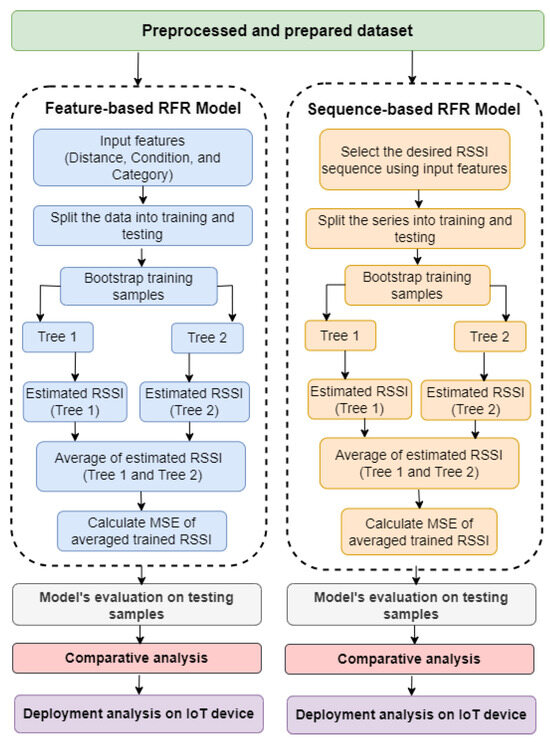
Figure 2.
The system model representing the RFR implementation on Feature-based and Sequence-based strategies.
4. RFR-Based LP-IoT Channel Estimation Models
This section demonstrates the LP-IoT channel estimation using the RFR algorithm, which is operated using a collection of decision trees. The output of all the trees is averaged for regression tasks to reduce variance and avoid over-fitting, which is a common issue in individual decision trees. Each tree is trained on a random subset of data with replacement (bootstrap samples). At each node, a subset of environment features (see Section 4.1) is randomly selected to determine the split, which enhances diversity among trees. In this section, the RFR algorithm has been applied in two variations, RFR(F) and RFR(S), which are detailed in the subsequent subsections.
4.1. RFR(F) Model
In the RFR(F) model, we utilised three LP-IoT channel environment features such as the distance between the transmitter and receiver, the environment condition (Line-of-Sight (LoS) and Non-Line-of-Sight (NLoS)), and the category showing the fixed location, varying location, or varying distance and location between the transmitter and receiver [30]. We input the three features into the RFR model to estimate the RSSI against those features. The following equation expresses the high-level RFR(F) model mathematically:
where denotes the input to the modela and represents the output, which is the estimated wireless channel (RSSI). The variable s indicates the distance between the transmitter and receiver, c denotes the LoS/NLoS condition, and g represents the scenario category. We used the distance as numerical input ranges from 0.2 m to 3 m. The condition feature is encoded as and , and the category is encoded as 0 for fixed location RSSI, 1 varying location, and 2 for varying distance and location between the transmitter and receiver. For the RFR(F) model’s construction, we utilised two decision trees for bootstrapping. Bootstrapping is a process of randomly selecting the samples from the dataset with its replacements to create a sample of the same size as the original dataset. We created a bootstrap sample of the dataset for each tree in the forest. To cover sample size with replacements, some samples appear multiple times, while others might not be included. Each tree is built on different bootstrap samples. This iterative bootstrapping process continues until the nodes are extended to a level where all leaves are either pure or contain fewer samples than the specified minimal threshold in each split. When splitting a node during the tree’s construction, we select the random subset of the features at each split instead of considering all features. For example, only two of the three features (e.g., distance and condition) might be considered for the split. This randomness ensures the diversity of the algorithm. For the prediction, the new sample is passed through all the trees in the forest. Each tree gives a prediction of the RSSI value based on its structure. The overall forecast is determined by averaging the estimations generated by all the trees. Given that the input features can be represented as , the RFR(F)-based estimated outcome , also represented as , can be mathematically expressed as the average of the predictions from the two trees:
where and represent the two trees in the RFR model and and are the predictions from trees and using the three input features.
Training and Evaluation
To evaluate the RFR(F) model, we utilised of the data for training and for testing. The K-Fold Cross-Validation method was performed by splitting the training dataset into K-folds for cross-validation, where in the RFR(F) model, as shown in Figure 3. We made sure to use the same split in training as in testing to ease the evaluation. The constructed models were then trained on the training portion of the fold. Finally, we predicted the RSSI on the training and testing portions of each fold by calculating the Mean Squared Error (MSE) for both training and testing predictions for each fold. This evaluation metric, MSE, allows for comparing the model’s performance on unseen data, ensuring that the model generalises well beyond the training set.
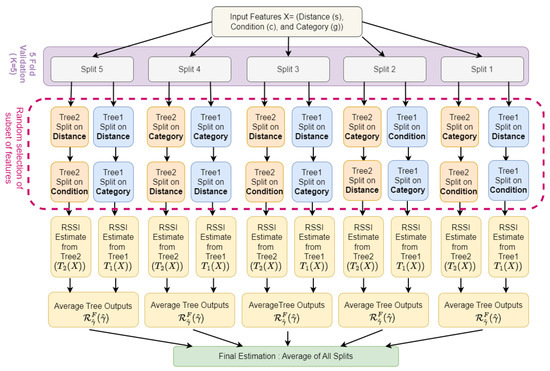
Figure 3.
The structure of Feature-based RFR (RFR(F)) model.
4.2. RFR(S) Model
In the Sequence-based strategy, we select a specific subset of data from a prepared dataset that contains RSSI values. The prepared dataset is structured with three primary features: distance, condition, and category, as explained in Section 4.1. A combination of these features, such as , is used to select the corresponding RSSI series. Specifically, this combination selects RSSI values where the distance is 3 m, the condition LoS has a value of 0, and the fixed location of the receiver has a category value of 0, as shown in Figure 4. The selected subset of RSSI values, extracted from the dataset’s fourth column, is then transformed into a time series. Then, we feed the selected RSSI series into the RFR(S) model for training and estimation. The high-level expression of the RFR(S) model is as follows:
where denotes feature combinations used to select an RSSI series, indicates the selected sequence of RSSI against the selected feature combination of s, c, and g, and represents the estimated output of RFR(S) model. Considering the selected RSSI sequence as a time series, we transform this series into a supervised learning problem called ‘Sliding Window’. In this method, we use the RSSI (selected using the combination of different features) at previous time steps as features and estimate the RSSI at the next time step using the previous values with a lag of 3, such that . This method is implemented in time series forecasting using the RFR algorithm to create a regression problem from the time series data effectively. To represent the function of single tree model in a generalised manner, let us consider the selected series of RSSI values denoted as , where t represents a specific time stamp. If we assume n lagged values as features, the predicted RSSI, denoted as , can be estimated as a function of the previous as follows:
where is the estimated RSSI at timestamp , n represents the number of the lagged RSSI values used as features, and denotes the estimation from a single tree. The RFR(S) model can be mathematically expanded as follows:
where represents the final estimation through the RFR(S) algorithm with two estimators, such that , trained through bootstrapping on historical data to map the lagged RSSI values to future values; T represents the number of trees in the RFR model and is the estimation from the tree in the forest. These representations model the RFR(S)’s operation for time series forecasting by utilising the dependency of future RSSI values on past observations through an ensemble learning approach, as shown in Figure 5.
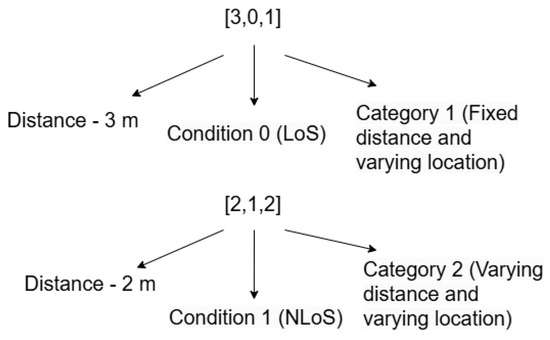
Figure 4.
The visualisation of the combination of environment features utilised in the RFR(S) model.
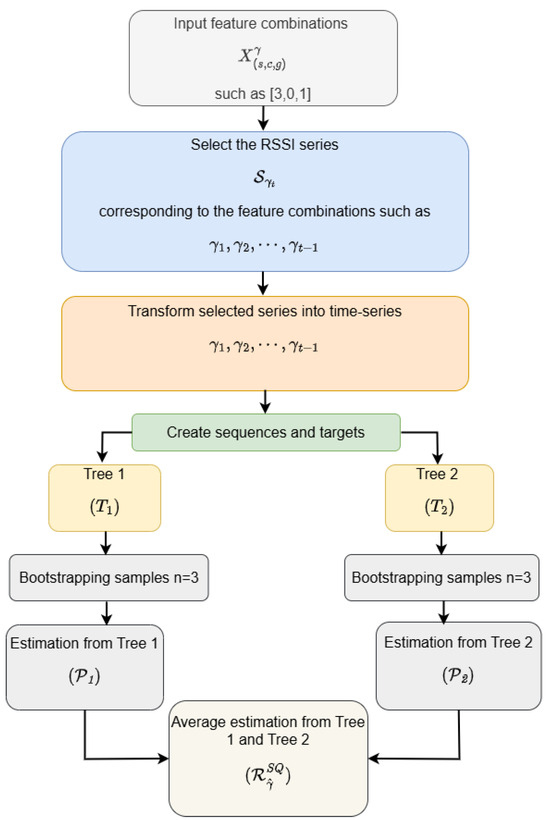
Figure 5.
The structure of the Sequence-based RFR (RFR(S)) model.
Training and Evaluation
To prepare the data for training the Random Forest Regressor RFR(S), the selected time series is divided into sequences. A sliding window approach is applied, where each sequence is of length input size, determined as 3 for this study. This window moves through the time series, creating sequences and corresponding target values. The sequences consist of consecutive RSSI values, and the target is the RSSI value immediately following each sequence. The generated sequences and their corresponding targets are then split into training and testing datasets. The training set comprises 80% of the sequences, with the remaining 20% reserved for testing. This split ensures that the model is trained on a adequate volumne of data while retaining a portion of the data for evaluation. The created sequences of size 3 are then used as an input to the model.
The training process involves fitting the model to the training sequences and their corresponding targets. The fitting process is conducted over a short duration, with no folds as the sequence window is short-length of 3. Thus, the training process is quite straightforward. The RFR(S)’s performance was evaluated using the MSE and RMSE evaluation metrics. After training, the model’s predictive performance is further evaluated using the testing dataset. Predictions are made on the testing sequences, and the MSE and RMSE are calculated for this dataset.
5. Deployment on LP-IoT Device
The deployment of the ML-based models serves as the connection between the model development environment where the models are developed and the practical execution of the models in a real-world setting. During the deployment phase of our research, we employed Raspberry Pi 4 Model B as our LP-IoT device. The Raspberry Pi 4 B is a powerful single-board computer, well-suited for running highly complex ML-based algorithms due to its enhanced processing capabilities and increased memory compared to its previous versions. The device features a quad-core Broadcom BCM2711, with Cortex-A72 (ARM v8) 64-bit system SoC @ 1.5 GHz. The available RAM options include 2 GB, 4 GB, 6 GB, and 8 GB of LPDDR4-3200 SDRAM. We opted for the 8 GB version to fully leverage the microprocessor’s capabilities. During the initial setup, we inserted a microSD card, linked peripheral devices, and configured fundamental parameters such as network connectivity. Subsequently, we installed the latest version of Python and proceeded to install Jupyter Notebook on Raspberry Pi 4 B. We executed the models by launching Jupyter in the browser and navigating to the location of the model scripts. The initial configuration and setup can be accessed through [31]. During the complexity analysis, we collected the complexity parameters, including CPU utilisation and memory consumption, for both RFR-based models during the training and testing stages. In addition, we also deployed the previously constructed ANN-based models to compare the complexity of the RFR model with the ANN-based approaches (as described in Section 6.3).
6. Results and Discussion
This section presents the findings from implementing RFR(F) and RFR(S) models for indoor RSSI estimation in LP-IoT networks. The subsequent subsections describes the estimation outcome, comparison with other models, and the complexity analysis of the developed models.
6.1. Estimation
For the RFR(F) model, the training and testing phases are visualised in Figure 6, while the estimation outcome—including the training error (MSE,RMSE), testing error (MSE,RMSE), training time and testing time, are detailed in Table 2. The training MSE of dBm, along with the testing MSE of dBm, indicates the higher accuracy of this model. The training time of 0.0134 s and the testing time of 0.0010 s signifies the model’s efficiency. In an RFR(S) model, we utilised a variety of feature combinations such as and . These combinations show the LoS and NLoS conditions with a fixed distance of 3 and varying receiver locations. Similarly, the combinations from to show the LoS and NLoS conditions with varying receiver distances and locations. The RFR(S) model’s outcome using these feature combinations demonstrates the model’s viability in handling the different RSSI series. Figure 7, Figure 8, Figure 9, Figure 10, Figure 11, Figure 12, Figure 13 and Figure 14 illustrate the training and testing phases for the selected sequences of feature combinations. We evaluated the model’s performance by obtaining the MSE, Root Mean Squared Error (RMSE), training time, and testing time across these selected sequences. The estimation outcome of the selected RSSI series can be visualised in Table 3. Additionally, it is to be noted that the RFR(S) model (in Table 3) demonstrates varying levels of MSE across different sequences during the training and testing phases. For instance, the sequence using features shows the training MSE of dBm during the training phase. During the testing phase, there is a slight increment in the MSE of dBm. Despite these variations, the RFR(S) model demonstrates relatively lower MSE, RMSE, training, and testing times across all sequences, which indicates high computational efficiency.
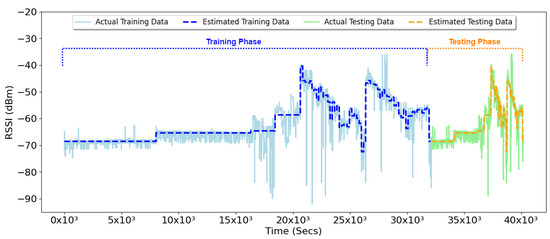
Figure 6.
Visual results of RFR(F) model for LP-IoT wireless channel estimation.

Table 2.
Comparative analysis of RFR(F) model with previously established ANN(F) model [30] and current models in the literature (TinyDraGon and Random Forest) based on Mean Squared Error (MSE), Root Mean Squared Error (RMSE), training time, and testing time.
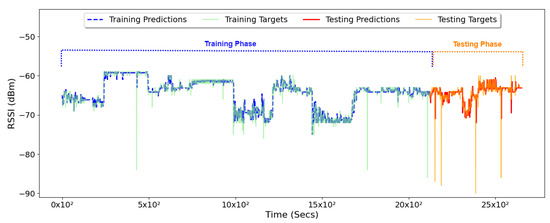
Figure 7.
The results of selected sequence using the features [3, 0, 1].

Figure 8.
The results of selected sequence using the features [3, 1, 1].
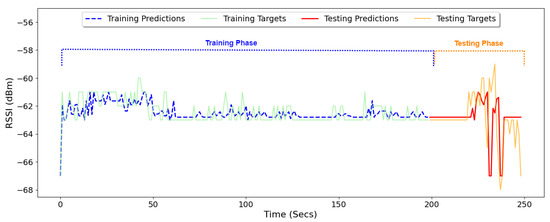
Figure 9.
The results of selected sequence using the features [2, 0, 2].
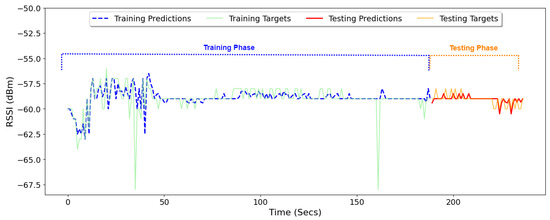
Figure 10.
The results of selected sequence using the features [2, 1, 2].
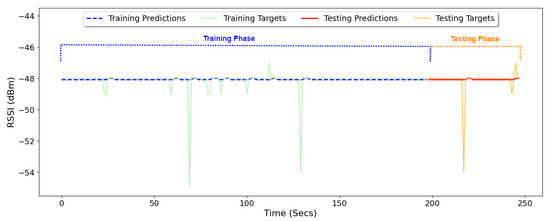
Figure 11.
The results of selected sequence using the features [1, 0, 2].
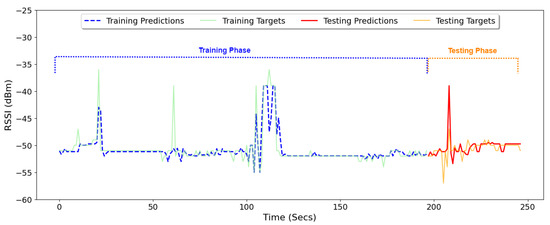
Figure 12.
The results of selected sequence using the features [1, 1, 2].
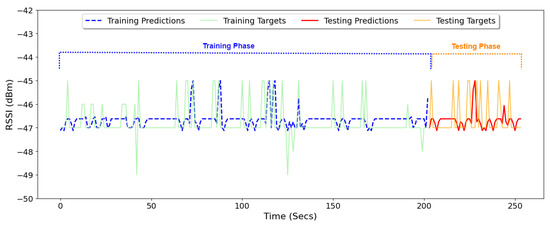
Figure 13.
The results of selected sequence using the features [0.5, 0, 2].
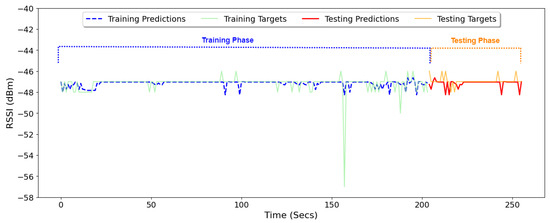
Figure 14.
The results of selected sequence using the features [0.5, 1, 2].

Table 3.
Comparative analysis of RFR(S) model against Sequence-based ANN model and current models (TinyDraGon and Random Forest).
6.2. Comparison
We now compare our RFR-based models with our predecessors: the ANN(F) and the ANN(S) models. From Table 2, we can observe that the estimation MSE and RMSE of ANN(F) model is dBm, which is higher than the RFR(F) estimation with a MSE of dBm and RMSE of dBm, which indicates the more accurate estimation of the RFR model over the ANN-based model. Similarly, we can also visualise the RFR(F) model’s superiority over the state-of-the-art studies in [17] based on a global method (utilising the entire dataset), and in [24], which evaluates the effectiveness of Random Forest to estimate RSSI in LoRaWAN for agricultural settings.
Next, the ANN(S) model was compared with the RFR(S) model. From this Table 3, we can visualise that the RFR(S) model has significantly lower MSE and RMSE than the ANN(S) model for most of the selected sequences. We also performed the averaged comparison by averaging the testing MSE of all the selected sequences for the RFR(S) and ANN(S) models. The averaged testing MSE of the RFR(S) model shows the dBm, while the ANN(S) model shows the average MSE of dBm, which is less than the RFR(S) model. In comparison with the state-of-the-art (TinyDraGon) model in [17], the higher testing MSE and RMSE of dBm and dBm also indicates the superiority of RFR(S) model over the TinyDraGon.
The significant outperformance of the RFR(F) and RFR(S) approaches compared to the conventional ANN(F) and ANN(S) methods can be attributed to differences in their underlying algorithms and their handling of dataset characteristics. The RFR(F) and RFR(S) methods benefit from an ensemble-based structure that aggregates predictions from multiple decision trees. This property makes them particularly effective in scenarios with complex, nonlinear relationships or variations that might lead to overfitting in other models. In our case, the specific features of the data that favour the RFR(F) and RFR(S) approaches include instances with noisy measurements and fluctuations in received signal strength. The RFR method is better equipped to handle these situations by averaging predictions across diverse trees, thereby reducing variance and improving generalisation. Moreover, the RFR method is less sensitive to small-scale variations in the dataset compared to ANN, which relies heavily on well-tuned hyperparameters and larger datasets for effective learning. This robustness gives RFR an advantage, especially when operating with limited or noisy data. However, as the dataset size increases and deployment scenarios scale up, ANN may achieve better accuracy due to its capability to learn complex patterns through deeper representations. In the current deployment scenario, RFR performs better generalisation and shorter training times.
6.3. Complexity Analysis
To analyse the complexity of the RFR(F) and RFR(S) models over ANN-based models, we deployed these models on Raspberry Pi 4 Model B. We focused on analysing the lightweightness of the models through key parameters such as CPU utilisation, average of four cores in (%), and memory usage in (MBs) during the training and testing phase. From Table 4, we can see that the RFR(F) demonstrates a considerable advantage in terms of resource efficiency. During the training phase, it consumes significantly less memory, 923 MBs, compared to the ANN(F) model with 1095.68 MBs. Also, it utilises only of CPU, while the ANN(F) utilises . During testing, the RFR(F) maintains lower memory usage and CPU utilisation compared to the ANN(F) model, which shows no reduction in memory usage but a drastic decrease in CPU utilisation to . Finally, we compare the CPU utilised by the RFR(S) with the ANN(S) model for the selected RSSI series, as illustrated in Figure 15, indicating the CPU utilisation in the training and testing phase of the RFR(S) and ANN(S) models. It is visibly clear that the ANN(S) utilises a higher CPU during training. However, the testing usage was less than RFR(S) only for the sequence with features . In the testing phase, both models show decreased CPU usage; however, the ANN Model still exhibits overall higher resource consumption than the RFR Model. Considering the combination of training time, memory usage, and CPU utilisation in training and testing as complexity parameters, we can observe the significantly greater efficiency of the RFR(S) model over the ANN(S) model. The reduced CPU usage during the testing phase of both models is obvious, as this task involves only evaluating the already trained models.

Table 4.
Complexity comparison on LP-IoT device between RFR(F) and ANN(F) model.
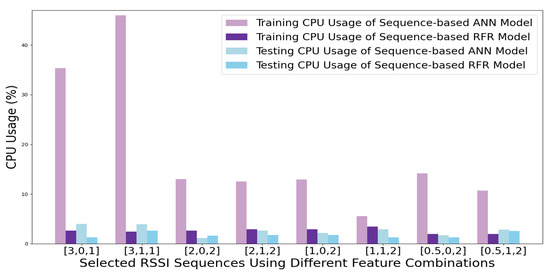
Figure 15.
Visualisation of CPU usage comparison of RFR(S) model with ANN(S) Model across different RSSI sequences.
Based on this analysis, the choice of model should be based on the alignment of the model with resource availability and performance requirements of the specific application. Thus, we consider the RFR(F) and RFR(S) as lightweight models based on their training time, testing time, and CPU utilisation. While the models show significant promise in improving estimation accuracy and reliability, scaling up their deployment in larger, more dynamic IoT environments may present challenges such as computational resource constraints, real-time processing limitations, and adaptability to diverse network conditions. Addressing these challenges will be a critical step toward ensuring the practical applicability of the models. This analysis is critical for understanding the accuracy and reliability of RSSI estimation, which is pivotal for designing robust and adaptive IoT systems in dynamic environments.
7. Conclusions and Future Work
This paper presented and evaluated the two innovative RFR-based models for estimating RSSI in indoor LP-IoT networks. Our research showed that the proposed models RFR(F) and RFR(S) outperform ANN-based models (ANN(F) and ANN(S)) in terms of accuracy and efficiency. This research also presented a notable improvement compared to the state-of-the-art ‘TinyDraGon’ model. The experimental results indicated that the RFR(F) technique exhibits an approximately 39.62% improvement in MSE over the ANN(F) model and a 37.86% improvement in MSE compared to TinyDraGon. Next, the RFR(S) model was analysed, and the results underscored the MSE reduction of 24.9% (the average of the testing MSEs of eight selected sequences in Table 3) over the ANN(F) model and an 80.59% reduction over TinyDraGon. In addition, we also performed the complexity analysis of our models by deploying the models on Raspberry Pi 4 Model B. The reduced CPU utilisation and memory usage of our RFR-based models not only validate their superiority but also highlight their practicality. This research represents a significant step forward in the development of efficient, accurate, and resource-conscious predictive models. Future work will focus on conducting a detailed probability analysis of the estimation error of the proposed models and exploring their scalability for larger networks in more complex IoT environments. Furthermore, a hybrid approach that combines the strengths of the ANN model and the RFR model will also be explored as a potential pathway forward. The potential improvements in the models’ application in different environmental characteristics will also be considered as a subsequent investigation topic to enhance the models’ adaptability and effectiveness across diverse settings.
Author Contributions
Conceptualisation, S.A., M.A.K. and S.u.R.; methodology, S.A., M.A.K. and S.u.R.; formal analysis, S.A. and M.A.K.; investigation, S.A., M.A.K. and S.u.R.; data curation, S.A.; writing—original draft preparation, S.A. and M.A.K.; writing—review and editing, S.A., M.A.K. and S.u.R.; supervision, M.A.K. and S.u.R.; All authors have read and agreed to the published version of the manuscript.
Funding
This research was funded by Australian Government Research Training Program (AGRTP) scholarship from Charles Sturt University, Australia.
Institutional Review Board Statement
Not applicable.
Informed Consent Statement
Not applicable.
Data Availability Statement
The data supporting the conclusions of this article will be made available by the authors on request.
Acknowledgments
The authors acknowledge the support received from School of Computing, Mathematics, and Engineering at Charles Sturt university.
Conflicts of Interest
The authors declare no conflicts of interest.
References
- Madakam, S.; Ramaswamy, R.; Tripathi, S. Internet of Things (IoT): A literature review. J. Comput. Commun. 2015, 3, 164. [Google Scholar] [CrossRef]
- Harsha, B.; Shalini, P.; Akhil, K.M. RSSI Based Pattern Classification in WSN Using Machine Learning. In Proceedings of the 2022 IEEE 7th International Conference on Recent Advances and Innovations in Engineering (ICRAIE), Mangalore, India, 1–3 December 2022; Volume 7, pp. 182–187. [Google Scholar]
- Dinev, D.; Haka, A. RSSI study of wireless Internet of Things technologies. J. Phys. Conf. Ser. 2022, 2339, 012014. [Google Scholar]
- Arif, S.; Khan, M.A.; Rehman, S. Wireless Channel Estimation for Low-Power IoT Devices Using Real-Time Data. IEEE Access 2024, 12, 17895–17914. [Google Scholar] [CrossRef]
- Rekkas, V.P.; Sotiroudis, S.P.; Koudouridis, G.P.; Sarigiannidis, P.; Zaharis, Z.D.; Karagiannidis, G.K.; Goudos, S.K. On the Accuracy and Efficiency of Received Signal Strength Modelling for a Forest Environment. In Proceedings of the 2024 IEEE International Conference on Machine Learning for Communication and Networking (ICMLCN), Stockholm, Sweden, 5–8 May 2024; pp. 399–404. [Google Scholar]
- Iwasaki, M.; Nishio, T.; Morikura, M.; Yamamoto, K. Transfer Learning-Based Received Power Prediction with Ray-tracing Simulation and Small Amount of Measurement Data. In Proceedings of the 2020 IEEE 92nd Vehicular Technology Conference (VTC2020-Fall), Victoria, BC, Canada, 18 November–16 December 2020; pp. 1–6. [Google Scholar]
- González-Palacio, M.; Tobón-Vallejo, D.; Sepúlveda-Cano, L.M.; Rúa, S.; Le, L.B. Machine-Learning-Based Combined Path Loss and Shadowing Model in LoRaWAN for Energy Efficiency Enhancement. IEEE Internet Things J. 2023, 10, 10725–10739. [Google Scholar] [CrossRef]
- Maduranga, M.; Abeysekara, R. Supervised machine learning for RSSI-based indoor localisation in IoT applications. Int. J. Comput. Appl. 2021, 183, 26–32. [Google Scholar]
- Arif, S.; Khan, M.A.; Rehman, S. Deep Learning Approaches to Indoor Wireless Channel Estimation for Low-Power Communication. In Proceedings of the 2024 IEEE International Conference on Communications Workshops (ICC Workshops), Denver, CO, USA, 9–13 June 2024; pp. 1547–1552. [Google Scholar]
- Saitoh, K. Deep Learning from the Basics: Python and Deep Learning: Theory and Implementation; Packt Publishing Ltd.: Birmingham, UK, 2021. [Google Scholar]
- Hu, Q.; Gao, F.; Zhang, H.; Jin, S.; Li, G.Y. Deep Learning for Channel Estimation: Interpretation, Performance, and Comparison. IEEE Trans. Wirel. Commun. 2021, 20, 2398–2412. [Google Scholar]
- Hoang, M.T.; Yuen, B.; Dong, X.; Lu, T.; Westendorp, R.; Reddy, K. Recurrent Neural Networks for Accurate RSSI Indoor Localisation. IEEE Internet Things J. 2019, 6, 10639–10651. [Google Scholar] [CrossRef]
- Ye, H.; Li, G.Y.; Juang, B.H. Power of Deep Learning for Channel Estimation and Signal Detection in OFDM Systems. IEEE Wirel. Commun. Lett. 2018, 7, 114–117. [Google Scholar]
- Debnath, S.; O’Keefe, K. Proximity Estimation with BLE RSSI and UWB Range Using Machine Learning Algorithm. In Proceedings of the 2023 13th International Conference on Indoor Positioning and Indoor Navigation (IPIN), Nuremberg, Germany, 25–28 September 2023; pp. 1–6. [Google Scholar]
- Biau, G.; Scornet, E. A random forest guided tour. Test 2016, 25, 197–227. [Google Scholar] [CrossRef]
- Rifki, M.I.; Ikhwan, A.; Muhammad, F. Performance Evaluation of RSSI Prediction Methods in Wireless Communication Networks. ZERO J. Sains Mat. Dan Terap. 2024, 8, 7–18. [Google Scholar] [CrossRef]
- Geis, M.; Sliwa, B.; Bektas, C.; Wietfeld, C. TinyDRaGon: Lightweight radio channel estimation for 6G pervasive intelligence. In Proceedings of the 2022 IEEE Future Networks World Forum (FNWF), Montreal, QC, Canada, 10–14 October 2022; pp. 658–663. [Google Scholar]
- Khan, K.; Iqbal, M.; Salami, B.A.; Amin, M.N.; Ahamd, I.; Alabdullah, A.A.; Arab, A.M.A.; Jalal, F.E. Application of Advanced Machine Learning and Artificial Neural Network Methods in Wireless Sensor Networks Based Applications. Int. J. Eng. Adv. Technol. 2022, 11, 103–109. [Google Scholar]
- Wang, Y.; Jia, Z.; Gan, R.; Li, J.; Xiao, Z. Evaluate Link Quality based on ISSA-BRF in Wireless Network. In Proceedings of the 2024 5th International Conference on Computing, Networks and Internet of Things, CNIOT ‘24, Tokyo, Japan, 24–26 May 2024; pp. 19–25. [Google Scholar]
- Azoulay, R.; Edery, E.; Haddad, Y.; Rozenblit, O. Machine learning techniques for received signal strength indicator prediction. Intell. Data Anal. 2023, 27, 1167–1184. [Google Scholar]
- Kumara, D.H.; Song, Z.; Rahmadya, B.; Kozume, S.; Sumiya, T.; Sun, R.; Takeda, S.; Wang, X. Indoor Area Estimation System Using RSSI-Measuring Handheld Reader Utilizing Directional Reference RFID Tags and Machine Learning. IEEE Access 2024, 12, 157872–157887. [Google Scholar]
- Aarif, L.; Tabaa, M.; Hachimi, H. RSSI prediction and optimisation of transmission power for improved LoRa communications performance. Ann. Telecommun. 2024, 1–20. [Google Scholar] [CrossRef]
- Ballestrin, R.; Feijó, J.F.; Feldman, M.; Müller, I. Exploring Machine Learning Techniques for Path Loss Prediction in LoRa Networks. In Proceedings of the 2024 19th International Symposium on Wireless Communication Systems (ISWCS), Rio de Janeiro, Brazil, 14–17 July 2024; pp. 1–6. [Google Scholar]
- Ramos, B.; Rosario, E.D.; Tovar, N. Assessing the Capability of Random Forest to Estimate Received Power in LoRaWAN for Agricultural Settings Using Climate Data. In Proceedings of the 2023 33rd International Telecommunication Networks and Applications Conference, Melbourne, Australia, 29 November–1 December 2023; pp. 234–239. [Google Scholar]
- Barrios-Ulloa, A.; Hoz-Franco, E.D.L.; Cama-Pinto, A. Comparison of machine learning path loss model for wireless sensor networks in cassava crops. In Proceedings of the 2023 IEEE Colombian Caribbean Conference (C3), Barranquilla, Colombia, 22–25 November 2023; pp. 1–6. [Google Scholar]
- Mallikarjun, S.B.; Kusumapani, S.C.; Kuruvatti, P.N.; Bhat, B.G.; Schotten, H.D. Machine Learning Based SINR Prediction in Private Campus Networks. In Proceedings of the 2023 IEEE 97th Vehicular Technology Conference (VTC2023-Spring), Florence, Italy, 20–23 June 2023; pp. 1–6. [Google Scholar]
- Dhama, S.; Akhtar, N.; Hathi, P.; Agnihotri, S. Downlink SNR Estimation of Wi-Fi Clients using Machine Learning. In Proceedings of the 2023 15th International Conference on COMmunication Systems NETworkS (COMSNETS), Bangalore, India, 3–8 January 2023; pp. 410–413. [Google Scholar]
- Kanto, Y.; Watabe, K. Wireless Link Quality Estimation Using LSTM Model. In Proceedings of the NOMS 2024—2024 IEEE Network Operations and Management Symposium, Seoul, Republic of Korea, 6–10 May 2024; pp. 1–5. [Google Scholar]
- Raj, N.; Vineeth, B. Indoor RSSINet-Deep learning based 2D RSSI map prediction for indoor environments with application to wireless localisation. In Proceedings of the 2023 15th International Conference on COMmunication Systems and NETworkS (COMSNETS), Bangalore, India, 3–8 January 2023; pp. 609–616. [Google Scholar]
- Arif, S.; Khan, M.A.; Rehman, S.; Abbas, S.M. RSSI Estimation for Constrained Indoor Wireless Networks Using ANN. In Proceedings of the 2024 International Conference on Electrical, Computer and Energy Technologies (ICECET), Sydney, Australia, 25–27 July 2024; pp. 1–6. [Google Scholar]
- Karthikeyan, S.; Raj, R.A.; Cruz, M.V.; Chen, L.; Vishal, J.L.A.; Rohith, V.S. A Systematic Analysis on Raspberry Pi Prototyping: Uses, Challenges, Benefits, and Drawbacks. IEEE Internet Things J. 2023, 10, 14397–14417. [Google Scholar] [CrossRef]
Disclaimer/Publisher’s Note: The statements, opinions and data contained in all publications are solely those of the individual author(s) and contributor(s) and not of MDPI and/or the editor(s). MDPI and/or the editor(s) disclaim responsibility for any injury to people or property resulting from any ideas, methods, instructions or products referred to in the content. |
© 2025 by the authors. Licensee MDPI, Basel, Switzerland. This article is an open access article distributed under the terms and conditions of the Creative Commons Attribution (CC BY) license (https://creativecommons.org/licenses/by/4.0/).